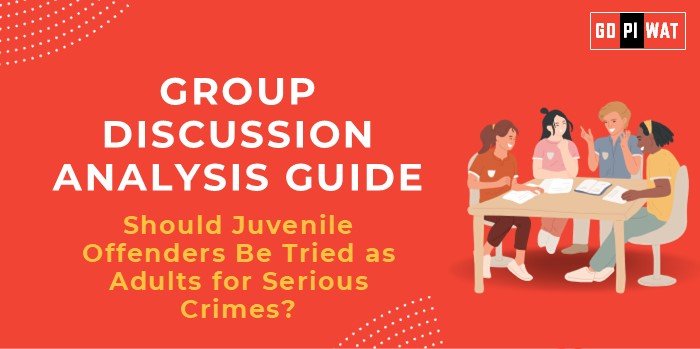📋 Group Discussion (GD) Analysis Guide: Should Juvenile Offenders Be Tried as Adults for Serious Crimes?
🌐 Introduction to the Topic
- 📜 Opening Context: Juvenile justice remains a contentious issue globally, especially when addressing grave crimes like murder or assault. Balancing rehabilitation with societal protection poses ethical and practical challenges.
- 📖 Background: Juvenile justice laws aim to rehabilitate offenders under 18, presuming they lack the maturity to understand the gravity of their actions fully. Yet, heinous crimes by juveniles have fueled debates on whether they should face adult trials for better deterrence and justice.
📊 Quick Facts and Key Statistics
- 📈 Juvenile Crime Rates: Over 7% of crimes in India (2022) were committed by juveniles.
- 🌍 Age of Criminal Responsibility: Varies globally, from 10 years (UK) to 18 years (India).
- 📉 Recidivism Rates: Juvenile offenders reoffend at a 24% lower rate when rehabilitated compared to adult trials (UNICEF, 2022).
- ⚖️ Landmark Case: The 2012 Delhi gang rape case included a juvenile offender, fueling debates on age-appropriate punishments.
👥 Stakeholders and Their Roles
- 🏛️ Government: Legislates juvenile justice laws and monitors their effectiveness.
- ⚖️ Judiciary: Ensures fair trials and assesses juveniles’ mental maturity.
- 🌐 NGOs/Child Rights Activists: Advocate for rehabilitation-focused approaches.
- 🗣️ Victims’ Families: Demand justice proportionate to the crime’s severity.
- 🤝 Society: Expects safety and crime deterrence mechanisms.
🏆 Achievements and Challenges
✨ Achievements
- 📚 Rehabilitation Centers: Significant improvement in reforming juveniles via specialized training.
- 🤝 Restorative Justice Programs: Reduced recidivism through victim-offender dialogues.
- 🌍 Global Models: Scandinavian countries have 90% success rates with rehabilitation-based approaches.
⚠️ Challenges
- 🛑 Public Outcry: Cases involving minors in heinous crimes strain the justice system.
- 📉 Insufficient Resources: Lack of well-equipped juvenile reform facilities.
- 💡 Maturity Dilemma: Psychologists often debate whether a teenager understands the consequences of severe crimes.
Global Comparisons:
• USA: Some states allow juvenile trials as adults for murder and other violent crimes.
• Norway: Strong focus on rehabilitation, with no juvenile incarceration for crimes under 15.
Case Study:
• India: In the Delhi 2012 gang rape, the involvement of a juvenile sparked legal reforms lowering the adult trial age for heinous crimes from 18 to 16.
📢 Structured Arguments for Discussion
- 💬 Supporting Stance: “Juvenile offenders in serious crimes should face adult trials to ensure justice for victims and deter potential offenders.”
- 🗣️ Opposing Stance: “Juveniles lack the emotional maturity to understand crime severity; rehabilitation ensures societal reintegration.”
- ⚖️ Balanced Perspective: “While adult trials may be necessary for grave crimes, rehabilitation should remain the cornerstone for juveniles.”
📈 Effective Discussion Approaches
- 💡 Opening Approaches:
- “Given that juvenile crime rates are rising, is age-appropriate punishment still effective for serious offenses?”
- 💡 Counter-Argument Handling:
- Data-Based: Highlight rehabilitation success rates or contrasting outcomes from other countries.
- Ethical Angles: Emphasize restorative justice principles.
📊 Strategic Analysis of Strengths and Weaknesses
Strengths
- 🤝 Rehabilitation reduces recidivism.
- 📜 Upholds child rights.
Weaknesses
- 📉 Heinous crimes challenge public trust in lenient laws.
Opportunities
- 🌍 Developing specialized hybrid legal systems.
Threats
- ⚠️ Public backlash could lead to poorly considered legal reforms.
🎓 Connecting with B-School Applications
- 💡 Real-World Applications:
- Useful for CSR projects on legal reforms or crime prevention.
- 💡 Sample Interview Questions:
- “What lessons can India draw from global juvenile justice models?”
- “How should businesses address youth crime through community programs?”
- 💡 Insights:
- Advocacy and social leadership roles offer B-school students practical learning opportunities.


